The other day, during a ride in Queens and Brooklyn, I detoured to the Ridgewood Reservoir. Because the loop around it is flat, I can ride around it a few time and add a few kilometers/miles to my ride without trying. (I recently learned that the loop is 1.2 miles, or about .7 kilometers: longer than I thought it is!) I was enjoying myself on a sunny, breezy afternoon when I made the turn near the Brooklyn side. There, two young men on ebikes without pedal assists whipped around the curve. One of them popped a wheelie and veered to his left-my right. I had almost no room to maneuver: I was well near the right edge of the lane and, even if I could have cut in front of him without colliding, I almost surely would have hit, or been hit by, the other guy on eBike, a cyclist riding in the opposite direction, or a group of people walking with a dog.
The guys on eBikes were going as fast, it seemed, as the car traffic on the nearby Jackie Robinson Parkway. Lately, I've wondered whether those bikes seem faster because I'm getting older and slower. But that experience--and a couple of reports that have come my way--show me that those machines are indeed getting faster and because prohibitions against them on bike and pedestrian lanes and speed limits are never enforced (if indeed they exist), too many riders seem to feel no compunction about endangering other people.
Folks like David Rennie in Park City,Utah are having similar experiences to mine on bike lanes and hiking trails. In a letter to the Park Record, he says that allowing such bikes on trails is "an accident waiting to happen" and can "see no reason why throttle-controlled e-bikes should not be treated exactly the same as a petrol-driven bike, and subject to the same licensing and use rules."
 |
| From Electric Bike Action |
In another Park Record letter to the editor, Mike Miller echoed his concerns and concluded that throttle-driven bikes without pedal assists are really "motorcycles" and should be treated as such.
.jpg)




